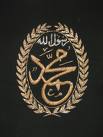As time passed, more reporters were involved in each isnad (chain of narrators), and so the situation demanded strict discipline in the acceptance of hadiths; the rules regulating this discipline are known as mustalahal-hadith (Hadith methodology).
Among the early traditionists (muhaddithun, scholars of Hadith), the rules and criteria governing their study of Hadith were meticulous, but some of their terminology varied from person to person, and their principles began to be systematically written down, but scattered among various books; for example, in Ar-Risalah of Ash-Shafi`i (d. AH 204), the introduction to the Sahih of Muslim (d. AH 261) and the Jami`of At-Tirmidhi (d. AH 279). Many of the criteria of early traditionists, for example Al-Bukhari, were deduced by later scholars from a careful study of which reporters or isnads were accepted and rejected by them.
One of the earliest writings to attempt to cover methodology comprehensively, using standard (generally accepted) terminology, was the work by Ar-Ramahurmuzi (d. AH 360). The next major contribution was Ma`rifat `Ulum al-Hadithby Al-Hakim (d. AH 405), which covered 50 classifications of Hadith, but still left some points untouched; Abu Nu`aim Al-Asbahani (d. AH 430) completed some of the missing parts to this work. After that came Al-Kifayah fi `Ilm ar-Riwayah of Al-Khatib Al-Baghdadi (d. AH 463) and another work on the manner of teaching and studying Hadith. Later scholars were considered to be greatly indebted to Al-Khatib’s work.
After further contributions by Qadi `Iyad Al-Yahsubi (d. AH 544) and Abu Hafs Al-Mayanji (d. AH 580) among others, came the work which, although modest in size, was so comprehensive in its excellent treatment of the subject that it came to be the standard reference for thousands of scholars and students of Hadith to come, over many centuries until the present day:`Ulum al-Hadithof Abu `Amr `Uthman ibn As-Salah (d. AH 643), commonly known as Muqaddimat Ibn As-Salah(Muqaddimahof Ibn As-Salah), compiled while he taught in the dar al-Hadith (Hadith school) of several cities in Syria. Some of the numerous later works based on that of Ibn As-Salah are these:
- Al-Irshad, an abridgement ofMuqaddimah, by An-Nawawi (d. AH 676), which he later summarized in hisTaqrib. As-Suyuti (d. AH 911) compiled a valuable commentary on the latter entitledTadrib Al-Rawi.
- Ikhtisar `Ulum al-Hadithby Ibn Kathir (d. AH 774);Al-Khulasahby Al-Taibi (d. AH 743);Al-Minhalby Badr Ad-Din ibn Jama`ah (d. AH 733);Al-Muqni`by Ibn Al-Mulaqqin (d. AH 802); andMahasin al-Istilahby Al-Balqini (d. AH 805 ), all of which are abridgements ofMuqaddimatIbn As-Salah.
- Nukatby Az-Zarkashi (d. AH 794);At-Taqyid wal-Idahby Al-`Iraqi (d. AH 806); andAn-Nukatby Ibn Hajar Al-`Asqalani (d. AH 852), all of which are further notes on the points made by Ibn As-Salah.
- Alfiyyat al-Hadithby Al-`Iraqi, a rewriting ofMuqaddimahin the form of a lengthy poem, which became the subject of several commentaries, including two (one long, one short) by the author himself;Fath al-Mughithby As-Sakhawi (d. AH 903);Qatar ad-Durarby As-Suyuti; andFath al-Baqiby Sheikh Zakariya Al-Ansari (d. AH 928).
- Al-Iqtirahby Ibn Daqiq Al-`Id (d. AH 702);Tanqih al-Anzarby Muhammad ibn Ibrahim Al-Wazir (d. AH 840), which was the subject of a commentary by Al-Amir As-San`ani (d. AH 1182).
- Nukhbat al-Fikarby Ibn Hajar Al-`Asqalani, again the subject of several commentaries, including one by the author himself, one by his son Muhammad, and those of `Ali Al-Qari (d. AH 1014), `Abdur-Ra’uf Al-Munawi (d. AH 1031) and Muhammad ibn `Abdul-Hadi As-Sindi (d. AH 1138). Among those who rephrased theNukhbahin poetic form are At-Tufi (d. AH 893) and Al-Amir As-San`ani.
- Alfiyyat al-Hadithby As-Suyuti, the most comprehensive poetic work in the field;Al-Manzumahby Al-Baiquni, which was expanded upon by, among others, Az-Zurqani (d. AH 1122) and Nawab Siddiq Hasan Khan (d. AH 1307);Qawa`id at-Tahdithby Jamal Ad-Din Al-Qasimi (d. AH 1332).
- Tawjih an-Nazarby Tahir Al-Jaza’iri (d. AH 1338), a summary of Al-Hakim’sMa`rifah.
----Based on the book: An Introduction to the Science of Hadith, with the author's kind permission. Excerpted, with some modifications from: http://www.ymofmd.com/hadith/Intro_Science_Hadith/asa1.htm


.jpg)










Post a Comment